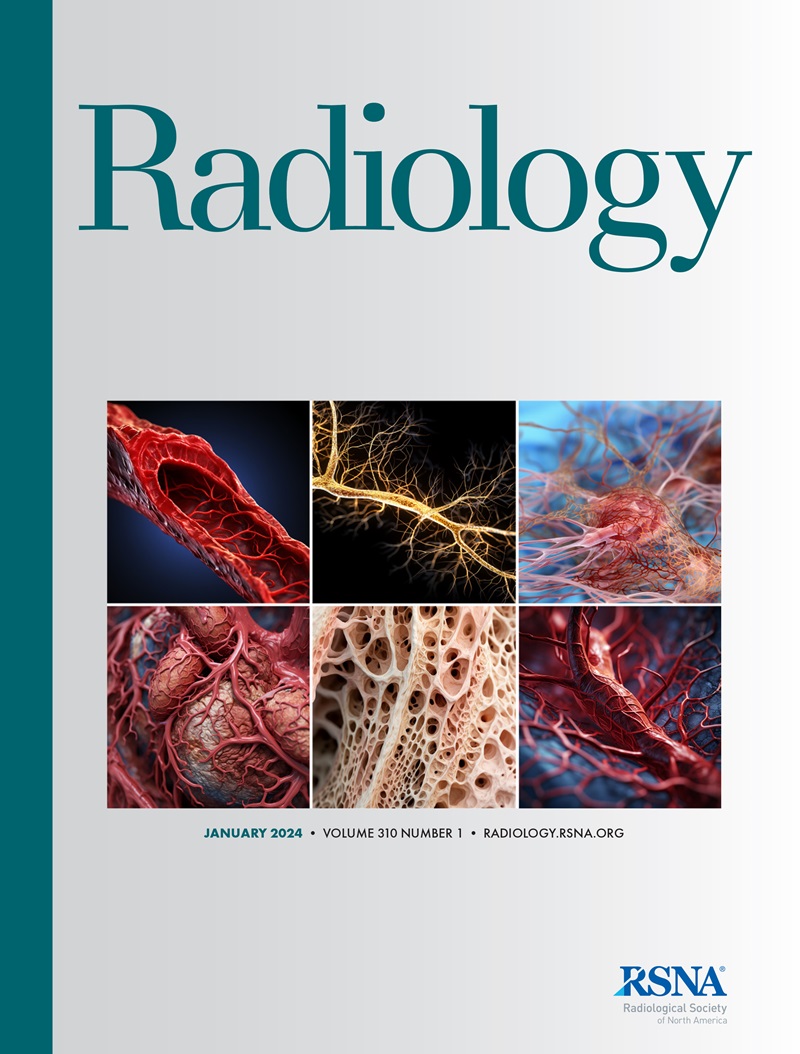求助PDF
{"title":"鹿特丹研究中颈动脉亚临床粥样硬化斑块组成的序列MRI演变。","authors":"Luoshiyuan Zuo, Maryam Kavousi, Hyunho Mo, Meike W Vernooij, Daniel Bos","doi":"10.1148/radiol.242248","DOIUrl":null,"url":null,"abstract":"<p><p>Background The co-occurrence of carotid plaque components within the same plaque could be a determinant of subclinical plaque evolution, which has largely been ignored. Purpose To investigate associations between pre-existing plaque compositions and new components within the same subclinical carotid plaque and describe the evolution of plaque compositions, focusing on age- and sex-specific patterns. Materials and Methods This prospective study, embedded within the Rotterdam Study, included participants aged 45 years and over with carotid intima-media thickness greater than 2.5 mm and two MRI examinations at baseline (October 2007 to November 2012) and 6-year follow-up (August 2014 to May 2017). All MRI examinations were performed at the Rotterdam Study research center on the same scanner. Plaque components, including calcification, intraplaque hemorrhage (IPH), and lipid-rich necrotic core, were evaluated by designated radiologists. To examine associations of baseline plaque compositions (combinations of individual components) with incident new components, generalized estimating equations were used to model longitudinal cluster data, calculate odds ratios (ORs) and 95% CIs, and adjust for confounders. Age-specific probabilities of changes in plaque compositions during follow-up were calculated, and a 30-year evolution of plaque compositions was simulated based on the Chapman-Kolmogorov equation. Results In total, 802 participants were included (mean age, 68.5 years ± 8.2 [SD]; 461 male), with only 2.9% of plaques (43 of 1460) having carotid stenosis exceeding 50%. Carotid plaques with calcification were independently associated with a higher incidence of IPH (adjusted OR, 2.00 [95% CI: 1.26, 3.16]; <i>P</i> = .003). In the simulated plaque evolution, multicomponent plaques represented 10% at age 55 years and increased to over 50% after age 70 years. Compared with women, men were more likely to have plaques with no component or a single component evolve to multicomponent plaques with IPH (men, 21% [116 of 558]; women, 13% [61 of 468]; <i>P</i> < .001). Conclusion Subclinical carotid plaques with pre-existing calcification are more likely to evolve into IPH than calcification-free plaques. Most subclinical carotid plaques progressed to multicomponent plaques in the simulated 30-year continuous plaque evolution, and men are more likely to develop multicomponent plaques with IPH. © RSNA, 2025 <i>Supplemental material is available for this article.</i></p>","PeriodicalId":20896,"journal":{"name":"Radiology","volume":"315 3","pages":"e242248"},"PeriodicalIF":15.2000,"publicationDate":"2025-06-01","publicationTypes":"Journal Article","fieldsOfStudy":null,"isOpenAccess":false,"openAccessPdf":"","citationCount":"0","resultStr":"{\"title\":\"Evolution of Subclinical Carotid Atherosclerotic Plaque Composition Using Serial MRI in the Rotterdam Study.\",\"authors\":\"Luoshiyuan Zuo, Maryam Kavousi, Hyunho Mo, Meike W Vernooij, Daniel Bos\",\"doi\":\"10.1148/radiol.242248\",\"DOIUrl\":null,\"url\":null,\"abstract\":\"<p><p>Background The co-occurrence of carotid plaque components within the same plaque could be a determinant of subclinical plaque evolution, which has largely been ignored. Purpose To investigate associations between pre-existing plaque compositions and new components within the same subclinical carotid plaque and describe the evolution of plaque compositions, focusing on age- and sex-specific patterns. Materials and Methods This prospective study, embedded within the Rotterdam Study, included participants aged 45 years and over with carotid intima-media thickness greater than 2.5 mm and two MRI examinations at baseline (October 2007 to November 2012) and 6-year follow-up (August 2014 to May 2017). All MRI examinations were performed at the Rotterdam Study research center on the same scanner. Plaque components, including calcification, intraplaque hemorrhage (IPH), and lipid-rich necrotic core, were evaluated by designated radiologists. To examine associations of baseline plaque compositions (combinations of individual components) with incident new components, generalized estimating equations were used to model longitudinal cluster data, calculate odds ratios (ORs) and 95% CIs, and adjust for confounders. Age-specific probabilities of changes in plaque compositions during follow-up were calculated, and a 30-year evolution of plaque compositions was simulated based on the Chapman-Kolmogorov equation. Results In total, 802 participants were included (mean age, 68.5 years ± 8.2 [SD]; 461 male), with only 2.9% of plaques (43 of 1460) having carotid stenosis exceeding 50%. Carotid plaques with calcification were independently associated with a higher incidence of IPH (adjusted OR, 2.00 [95% CI: 1.26, 3.16]; <i>P</i> = .003). In the simulated plaque evolution, multicomponent plaques represented 10% at age 55 years and increased to over 50% after age 70 years. Compared with women, men were more likely to have plaques with no component or a single component evolve to multicomponent plaques with IPH (men, 21% [116 of 558]; women, 13% [61 of 468]; <i>P</i> < .001). Conclusion Subclinical carotid plaques with pre-existing calcification are more likely to evolve into IPH than calcification-free plaques. Most subclinical carotid plaques progressed to multicomponent plaques in the simulated 30-year continuous plaque evolution, and men are more likely to develop multicomponent plaques with IPH. © RSNA, 2025 <i>Supplemental material is available for this article.</i></p>\",\"PeriodicalId\":20896,\"journal\":{\"name\":\"Radiology\",\"volume\":\"315 3\",\"pages\":\"e242248\"},\"PeriodicalIF\":15.2000,\"publicationDate\":\"2025-06-01\",\"publicationTypes\":\"Journal Article\",\"fieldsOfStudy\":null,\"isOpenAccess\":false,\"openAccessPdf\":\"\",\"citationCount\":\"0\",\"resultStr\":null,\"platform\":\"Semanticscholar\",\"paperid\":null,\"PeriodicalName\":\"Radiology\",\"FirstCategoryId\":\"3\",\"ListUrlMain\":\"https://doi.org/10.1148/radiol.242248\",\"RegionNum\":1,\"RegionCategory\":\"医学\",\"ArticlePicture\":[],\"TitleCN\":null,\"AbstractTextCN\":null,\"PMCID\":null,\"EPubDate\":\"\",\"PubModel\":\"\",\"JCR\":\"Q1\",\"JCRName\":\"RADIOLOGY, NUCLEAR MEDICINE & MEDICAL IMAGING\",\"Score\":null,\"Total\":0}","platform":"Semanticscholar","paperid":null,"PeriodicalName":"Radiology","FirstCategoryId":"3","ListUrlMain":"https://doi.org/10.1148/radiol.242248","RegionNum":1,"RegionCategory":"医学","ArticlePicture":[],"TitleCN":null,"AbstractTextCN":null,"PMCID":null,"EPubDate":"","PubModel":"","JCR":"Q1","JCRName":"RADIOLOGY, NUCLEAR MEDICINE & MEDICAL IMAGING","Score":null,"Total":0}
引用次数: 0
引用
批量引用

 求助内容:
求助内容: 应助结果提醒方式:
应助结果提醒方式:


